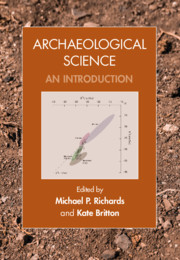Book contents
- Archaeological Science
- Archaeological Science
- Copyright page
- Contents
- Figures
- Tables
- Contributors
- Acknowledgements
- Part I Introduction
- Part II Biomolecular Archaeology
- Part III Bioarchaeology
- Part IV Environmental Archaeology
- 10 Vertebrate Zooarchaeology
- 11 Invertebrate Zooarchaeology
- 12 Palaeoethnobotany
- 13 Geoarchaeology
- Part V Materials Analysis
- Part VI Absolute Dating Methods
- Index
- References
13 - Geoarchaeology
from Part IV - Environmental Archaeology
Published online by Cambridge University Press: 19 December 2019
- Archaeological Science
- Archaeological Science
- Copyright page
- Contents
- Figures
- Tables
- Contributors
- Acknowledgements
- Part I Introduction
- Part II Biomolecular Archaeology
- Part III Bioarchaeology
- Part IV Environmental Archaeology
- 10 Vertebrate Zooarchaeology
- 11 Invertebrate Zooarchaeology
- 12 Palaeoethnobotany
- 13 Geoarchaeology
- Part V Materials Analysis
- Part VI Absolute Dating Methods
- Index
- References
Summary
In its broadest definition, geoarchaeology is the study of the archaeological record using any geoscience-based technique, method, concept, or knowledge (Rapp and Hill 2006). However, since archaeometry is a well-defined field focusing on the application of physical sciences to archeological prospecting, dating, and provenance (Waters 1992), it could be proposed that geoarchaeology has a more narrow definition, actually closer to the original coining of the term (Renfrew 1976) and to its modern main application. In this approach, geoarchaeology is the discipline that studies site stratigraphy and site formation processes, and the interaction of human and nature in shaping the landscape (Butzer 1982; French 2003; Goldberg and Macphail 2006; Waters 1992;). The history of this approach goes back several hundred years, as can be seen in the 1863 monograph of Sir Charles Lyell: Geological Evidences of the Antiquity of Man. However, it was not until 1976 that Colin Renfrew introduced and defined the term “geoarchaeology” in the preface of an edited volume by Davidson and Shackley (1976). Indeed, Renfrew (1976) defined precisely what should be the main concern of geoarchaeology, concisely summed up by Goldberg and Macphail (2006: 3): “geoarchaeology provides the ultimate context of all aspects of archaeology from understanding the position of a site in a landscape setting to a comprehension of the context of individual finds and features.”
- Type
- Chapter
- Information
- Archaeological ScienceAn Introduction, pp. 314 - 332Publisher: Cambridge University PressPrint publication year: 2020



